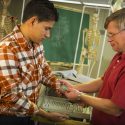American Indian documentary to examine ancestral origins of campus
A documentary examining the historical and contemporary triumphs and challenges of the American Indian peoples and Indian nations of the Great Lakes will air on the Wisconsin Channel (20.2) at 7 p.m. on Thursday, July 9.
The documentary, “UW Cultural Landscapes: First Nations,” is a collaborative effort of the University of Wisconsin–Madison’s American Indian Studies Program, American Indian Student Academic Services, Office of Human Resource Development, Office of the Vice Provost for Diversity and Climate, and Pathways to Excellence. It was created for the 2008 Plan 2008 Diversity Forum. Reruns will be shown at noon on Friday, July 10, and at 6 a.m. on Monday, July 13.
Aaron Bird Bear, former American Indian Student Academic Services student services coordinator and member of Mandan, Hidatsa and Dine’ Nations, narrates the documentary, which begins by highlighting the 12,000 years of history belonging to the Ho-Chunk ancestral homelands.
The Great Lakes American Indian people’s history is considerably linked with the history of UW–Madison, which has housed more than 30 ancient archaeological sites on current or former campus property and more effigy mounds than any other university in the world.
“I think we can really understand the relationship between American Indians and non-Indians through the evolution of the campus itself through the major phase of American Indian history,” Bird Bear says. “We move from what was once displacement and ethnic cleansing to mutual accommodation.”
The documentary guides viewers to some campus historical markers, landmarks and tributes to the university’s Native American ancestry including North and Bascom halls, which are historic land features built on effigy mounds, and the peace pipe incorporated into the crest of the Memorial Union.
“There is a very deep desire, historically speaking, within the American popular and cultural consciousness more broadly to pay tribute on some level to the continent’s original indigenous populations,” Ned Blackhawk, an associate professor of history and American Indian studies and member of Western Shoshone, says in the documentary. “On one hand, one wants to recognize that kind of desire to commemorate the original peoples of the continent, but on the other, one has to be troubled by how simplistic and reified these images have become.”
UW-Madison currently enrolls more than 300 self-identified American Indian and Alaskan Native peoples.
“My first year on campus was probably the most challenging, being born and raised on a reservation, coming here and not seeing anyone I felt like I could connect with,” UW–Madison alumna and member of Bad River Band Lake Superior Ojibwe Nicole Soulier says in the documentary. “But I think that once I got involved in community organizations, student organizations, campus organizations, that’s when I really started to feel that sense of belonging and investment, that I actually had a place here on campus.”
For more information on the Indigenous Great Lakes, visit UW–Madison’s Lakeshore Nature Preserve Web site.


